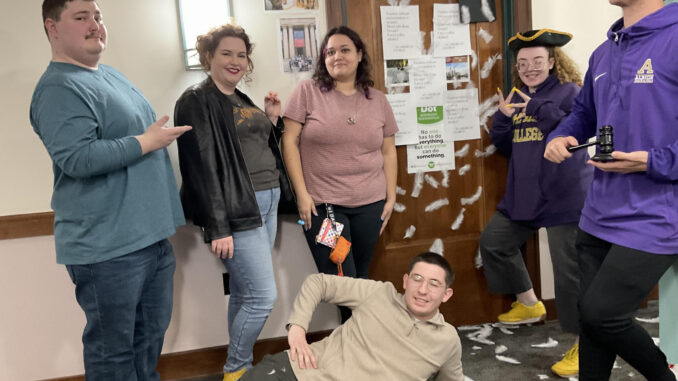
Depending on what type of college students attend, they may be subject to a 20-to-1 faculty ratio, like Central Michigan University. At Albion College, the student to faculty ratio is 11-to-1. Professor of history Marcy Sacks said, “when students trust that a faculty member sincerely cares about their learning,” she thinks “students are then more receptive to learning.”
“A good learning environment is one where there is trust, and trust doesn’t happen if you don’t have some kind of relationship,” Sacks said.
Assistant professor of history Christopher Riedel said that the “smaller” scale of Albion College makes it easier for students and professors to build connections.
“When you have classes of 10, 20, maybe 30 people instead of 300, it’s a lot easier to find a faculty member to connect with,” Riedel said. “Not everybody can make an impression in a huge lecture hall.”
Balancing Connection and Boundaries
Sacks said maintaining boundaries is important for both sides, but in some ways, she likes “blurring the boundaries.”
“My students know about my family and my cats because there are no true boundaries – you’re all part of my life,” Sacks said.
For Riedel, “there’s certainly a professional component to it,” but he’s still able to “sit down and have an hour-long conversation with a student who wants to know how to become a professor, or work on a senior thesis” since he doesn’t “have to do that fifty times a year for hundreds of students.”
Champlin, Minnesota, senior Nico Alfahed said that balance can also teach students how to “keep a friendly, comfortable rapport while staying professional.”
Alfahed added events like departmental gatherings help create those comfortable spaces.
“The psychology department has its own Brit Bash every year, and you get to meet professors outside of class,” Alfahed said. “I met professor Andrew Christopher a year before I ever had him, and that helped me feel more prepared when I finally took his class.”
Impact on Retention
According to Sacks, strong relationships are more than just a pleasant part of college life – they can directly influence whether students stay past their first semester. She said students without them “are more likely to leave because there’s nothing really anchoring them here.”
“If they haven’t connected with a faculty member who is helping them develop intellectually, then maybe they don’t persist very well,” Sacks said.
Riedel echoed that sentiment, and said faculty-student relationships are “critical to retention.”
“I think the students who don’t make those relationships are much more likely to leave,” Riedel said. “That’s what we offer that’s different from a big school – you’re not just a name on a roster. Professors know who you are, make jokes with you and find ways to connect with what you care about.”
Alfahed said faculty support helped him through early challenges in an internship.
“Professor Shanti Madhavan-Brown was such a helpful light, she was always checking in, making sure I had the support I needed,” Alfahed said.
Professor of biology Sheila Lyons-Sobaski said “most students who get connected with faculty probably choose to stay, unless we don’t provide the specific pathway they’re looking for,” adding that those connections make it “easier for them” to decide to stay.
St. Louis senior Caleb Galvan, who said he was “originally just a biology major,” took a course taught by associate professor of art Emmeline Solomon, and based on that decided “to keep pursuing art in some form.”
“She really helped me tap into my creative side and encouraged me to add an art minor,” Galvan said.
Staying Connected
Even after her students have graduated, Sacks said her relationships with them have continued.
“The whole reason I’m on Facebook is because of alumni,” Sacks said. “It’s my way of keeping up with former students who are now parents and have careers.”
Riedel said he maintains a similar practice and has had some of those connections last for years.
“I’m still close with a student who graduated more than four years ago,” Riedel said. “Every professor wants relationships like that – it’s one of the best parts of this job.”
Lyons-Sobaski said she also keeps in touch with former students and celebrates their success.
“We have a biology seminar coming up with a former student who told me I was an important support for him, and I didn’t even realize that,” Lyons-Sobaski said.
Sacks said she feels “fortunate” to watch students grow from first-years into graduates.
“I love teaching first-year students because it’s incredible to see their transformation and growth,” Sacks said. “If I didn’t have the connection with students, I wouldn’t want to get up and do what I do every day.”
With graduation in May, Alfahed said he plans to stay in touch with several mentors.
“I have professors who’ve helped me through family challenges,” Alfahed said. “I’ll definitely keep them updated on where life takes me.”
As Galvan also prepares to graduate this spring, he said he hopes to maintain his bonds with professors after graduation.
“I have an art Instagram page, so I’ll definitely let my professors follow that,” Galvan said. “It’s nice to know the connections you make here don’t just stop after you leave.”

Leave a Reply